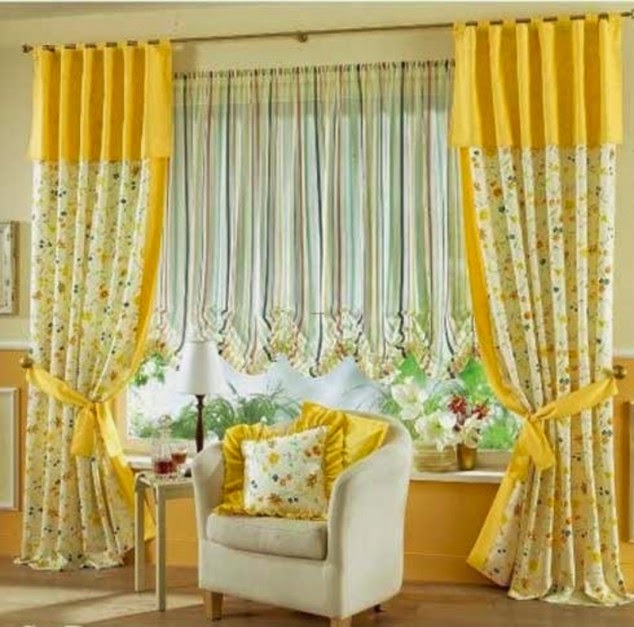 |
| How to Choose Color for your Curtains |
Still
one problem remains in deciding on style that of color. Since light and shade
change color, it does not pay to be overly fastidious about the degrees of
color used, but the choice of a hue is important, since this alone can change
the architecture and the mood of your room. You can, for example, make a small
room appear larger if you use different values of one color with a pale tint on
the walls, a darker tone for the rug and a tone somewhere in between for the
draperies. Also, red, orange, yellow and red-violet are "advancing"
colors and tend to bring walls forward, making a room smaller, whereas cooler
colors, blue, blue-violet, yellow-green, and green seem to recede, and give an
illusion of space.
Monochromatic
rooms are pleasant and fashionable, and in addition they make spaces seem
larger. In any color there is a wide range of tints and shades. Tints' have
white mixed with normal, pure colors, and 'shades* have darker tones by means
of black mixed into the pure hues. Also, you are closer to the mono-chromatic
idea if you use the secondary colors that are next to the primary colors on the
spectrum. That is, with blue have green and violet-blue, violet and yellow-green.
With red have yellow-orange, orange-red and red-violet. Depend on accessories
for your vivid splashes of contrasting color.
Contemporary
rooms favor large areas of white, natural color or gray in walls and fabrics,
with patterns in color laid over this as a background. If you find a fabric in
a. color scheme that delights you, you can build your room around the colors in
it.
 |
| How to Choose Color for your Curtains |
Colors
are said to produce certain emotions and reactions, although this, of course, depends on what colors are matched, and how they are used. Red, for instance,
is considered the most lively color. In its very vivid forms it is effective in
small amounts to add sparkle to a room. Tones of red that fit in with modern
nature colors and can be safely used in large quantities
are terracotta, shell-pink, rust and tangerine. Yellow in its paler, muted
forms in glass curtains gives bright cheerfulness to a room, as does orange.
Yellow glazed chintz can be attractive, but in rougher materials, gold, beige,
and other off tones are better. Green is considered very restful, the opposite
of red. Green becomes the basis for a group of correlated earthy tones, when
olive green is the basic color, and primrose yellow, cucumber, pale chartreuse,
sage, paleceladon, Lincoln green and scarab green are used. Blue was for a
long time avoided, as a cold color; but now blue is once more important,
especially in rooms where elegance is desired, as in Regency and Directoire,
and is used with white and gold. Dusty colors, that have gray mixed in them,
and gray itself, bring an element of peaceful repose into a room; and grays and
near-black colors such as black plum, smoke gray, and black are used with china
white, sky pink, tangerine, pearl gray, mocha and pomegranite for sophisticated
interiors. Black abstractions on white or neutral ground are seen more and more
in draperies.
Numerous
nontarnishing metallic yarns, some glinting subtly, others bright and shining,
are now avail-able, ranging from metallic lame to nubby materials with gold and
silver highlights in the weave.
Provincial
and Early American rooms use toile de Jouy fabrics in single colors of blue,
green, faded blue, wine, red or amethyst on off-white back- grounds. Butternut
is another provincial background color, successful with the painted woods,
fruit woods, and generally lighter furniture of this type of room.
You
have a greater opportunity to use color at your windows than in the past, since
fabrics are easier to wash and clean, and easier to keep clean. This fact also
makes it possible to use white in a carefree manner. While decorators have cut
down the palette for any one room, they have not become afraid of color. Dyes
are increasingly varied, and it is possible to find very pure bright colors and
subtle tints and shades in fabrics, ranging from gossamer gauze to sturdy duck


0 comments:
Post a Comment